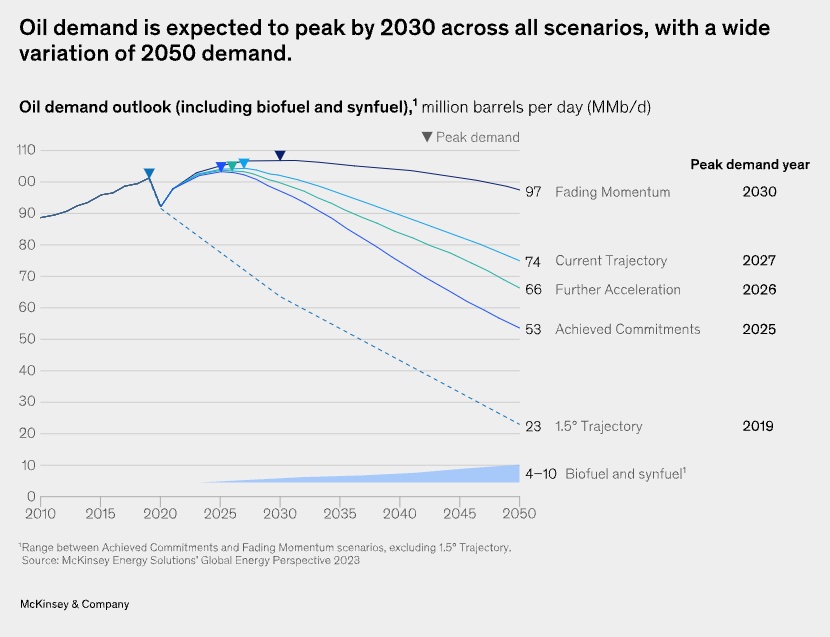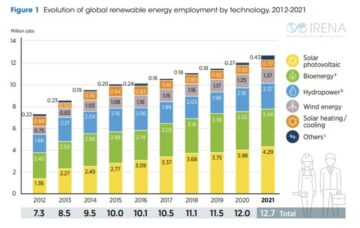Coming out of COP28, many climate analysts think 2023 was the year of "peak oil," preceding the terminal decline of a global economy powered by fossil fuels. In the United Nations’ assessment, last year marked the "beginning of the end" of the fossil fuel era.
Investors’ sustainability ambitions are only as viable as their investees’ progress on climate commitments. So what does the state of corporate progress towards emissions targets — a vital component of credible transition plans — say about the path investors could follow from this purported apex?
And if the decline has begun, what will be the consequences for investment strategies to generate sustainable, long-term value for retirees, general partners, and you and me?
Peak predictions
Fossil fuel use accounts for nearly 90 percent of all carbon dioxide emissions. In pursuit of both returns and net zero goals, investors must grapple with two key realities.
To start, this isn’t the first "beginning of the end" prognostication.
Royal Dutch Shell geologist M. King Hubbert predicted peak oil in the 1950s, forecasting the apex by 1970. A 1998 article in Scientific American said that production would likely wane "within 10 years," and BP’s 2020 annual energy outlook conceded that oil demand had already peaked.
All models are wrong despite some being useful, and this past year of war and windfalls delivered a different outlook.
Second, CDP, the global environmental disclosure system, finds that around a third of companies included in its commitment tracker are on or nearly on track to meet their emissions targets — worryingly, half of all disclosed emissions are not on track.
"Long-term objectives need to be married to interim progress, both from corporates and financial institutions," said Simon Fischweicher, head of corporations and supply chains for North America at CDP. "We have 4,466 companies with approved or validated science-based targets, but just 99 financial institutions who have set them … and only three from North America."

![]()
CDP has also seen a decline in both the number and the ambition of oil and gas company disclosures and commitments.
"That's a decline that isn't necessarily correlated to a terminal decline of the industry, nor investment that the industry is making in fossil fuel expansion or future financing."
Data dearth
None of this negates the reality that clean energy is booming. Forty percent of China’s GDP growth in 2023, for example, came from clean energy investment.
Private investors such as Apollo and Brookfield are, as my colleague Nico McCrossan covered last week, jumping into the deep end of clean energy and climate investment.
"What's most interesting is not what's in decline; people can speculate about that all day long. I like to think about what is accelerating, and we see tremendous opportunity for new ways to invest in the energy transition," said Carletta Ooton, head of ESG at Apollo, which has invested $31 billion on the way to its goal of deploying $50 billion in clean energy and climate capital by 2027.
Much of the lag in disclosure data from companies, according to Ooton, comes down to the ongoing lack of subject matter expertise and experience in companies. That said, sustainability roles are among the top fastest growing roles in the United States, and the regulatory push for sustainability disclosure is likely to further accelerate this trend.
In public markets, where engagement is regularly touted by the investment industry as the best tool to improve corporate sustainability performance, firms such as Legal & General Investment Management (LGIM) are using red lines in their engagement strategies.
"If companies don’t have sufficient disclosures or can’t demonstrate progress toward those red lines, that will escalate the vote against a director, and can escalate further to divestment," said Stephanie Lavallato, senior investment stewardship analyst at LGIM America.
The era of risk
LGIM’s standout stewardship performance demonstrates what engagement can achieve as a tool with teeth rather than a more blunt PR tool.
If we are (finally) on the downslope of oil and gas, investors of all stripes — "sustainable" or otherwise — will need to start thinking hard about looming risks.
In private market funds, where limited partners can’t easily withdraw their investment, the risk of being locked in to "transition-induced value erosion" is increasing. In public markets dominated by highly diversified and long-term universal owners, the decade of energy sector underperformance and the increasing risk of stranded assets will become more pressing.
If 2024 becomes, as United Nations secretary general António Guterres put it, "the year of exponential climate action," investors will be driven to face all of these considerations and questions.
- SEO Powered Content & PR Distribution. Get Amplified Today.
- PlatoData.Network Vertical Generative Ai. Empower Yourself. Access Here.
- PlatoAiStream. Web3 Intelligence. Knowledge Amplified. Access Here.
- PlatoESG. Carbon, CleanTech, Energy, Environment, Solar, Waste Management. Access Here.
- PlatoHealth. Biotech and Clinical Trials Intelligence. Access Here.
- Source: https://www.greenbiz.com/article/fossil-fuel-era-waning-heres-what-investors-need-know
- :has
- :is
- :not
- :where
- 10
- 15%
- 1998
- 2023
- 2024
- 24
- 31
- 7
- 90
- a
- About
- accelerate
- accelerating
- According
- Accounts
- Achieve
- Action
- against
- All
- already
- also
- ambition
- ambitions
- america
- American
- among
- analyst
- Analysts
- and
- annual
- Apex
- apollo
- approved
- ARE
- around
- article
- AS
- Assets
- At
- bbc
- BE
- become
- becomes
- Beginning
- begun
- being
- BEST
- Billion
- Bloomberg
- both
- but
- by
- CAN
- capital
- carbon
- carbon dioxide
- chains
- Chinas
- clean
- clean energy
- click
- Climate
- climate action
- CO
- colleague
- comes
- commitment
- commitments
- Companies
- company
- component
- Consequences
- considerations
- cop28
- Corporate
- corporates
- Corporations
- correlated
- could
- data
- day
- decade
- Decline
- deep
- delivered
- Demand
- demonstrate
- demonstrates
- Despite
- Director
- disclosure
- Disclosures
- diversified
- does
- dominated
- Dont
- down
- driven
- Dutch
- easily
- EC
- economy
- Emissions
- end
- energy
- engagement
- environmental
- Era
- escalate
- ESG
- Ether (ETH)
- Europa
- example
- expansion
- experience
- expertise
- exponential
- Face
- fastest
- fastest growing
- Finally
- finance
- financial
- Financial institutions
- financing
- finds
- firms
- First
- follow
- For
- fossil
- Fossil fuel
- fossil fuels
- Free
- from
- Fuel
- fuels
- funds
- further
- future
- GAS
- GDP
- gdp growth
- General
- generate
- Global
- Global economy
- goal
- Goals
- graphic
- Green
- Green Finance
- Growing
- Growth
- had
- Half
- Hard
- Have
- head
- highly
- HTTPS
- i
- if
- improve
- in
- included
- increasing
- industry
- institutions
- interesting
- interim
- into
- Invest
- invested
- investment
- Investors
- isn
- issues
- ITS
- jpg
- just
- Key
- King
- Know
- Lack
- Last
- Last Year
- Legal
- like
- likely
- Limited
- lines
- locked
- Long
- long-term
- looming
- Making
- management
- many
- marked
- Market
- Markets
- Matter
- McKinsey
- me
- Meet
- models
- more
- most
- move
- must
- my
- Nations
- nearly
- necessarily
- Need
- net
- New
- news
- Newsletter
- node
- nor
- North
- north america
- number
- objectives
- of
- Oil
- Oil and Gas
- on
- ongoing
- only
- Opportunity
- or
- otherwise
- our
- out
- Outlook
- partners
- past
- path
- Peak
- People
- percent
- performance
- plato
- Plato Data Intelligence
- PlatoData
- powered
- pr
- preceding
- presentation
- pressing
- private
- Production
- Progress
- public
- pursuit
- Questions
- rather
- realities
- Reality
- Red
- regularly
- retirees
- returns
- Risk
- risks
- roles
- s
- Said
- say
- scientific
- secretary
- sector
- see
- seen
- senior
- set
- Shell
- Simon
- So
- some
- standout
- start
- State
- States
- Stewardship
- strategies
- Stripes
- subject
- such
- sufficient
- supply
- Supply chains
- Sustainability
- sustainable
- system
- T
- targets
- Terminal
- than
- that
- The
- The State
- their
- Them
- These
- think
- Thinking
- Third
- this
- those
- three
- to
- tool
- top
- toward
- towards
- track
- transition
- tremendous
- Trend
- two
- UN
- United
- united nations
- United States
- use
- useful
- validated
- value
- viable
- vital
- Vote
- war
- was
- Way..
- ways
- we
- weekly
- What
- What is
- which
- WHO
- will
- with
- withdraw
- within
- would
- Wrong
- year
- years
- you
- youtube
- zephyrnet
- zero











